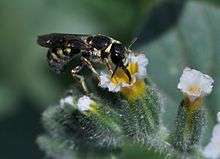Ochreriades
Ochreriades is a suprageneric lineage within Megachilidae. This genus can be considered the sister lineage "to a clade consisting of the “core” Osmiini, the tribe Megachilini and the genera Pseudoheriadesand Afroheriades."[1]
| Ochreriades | |
|---|---|
 | |
| Ochreriades fasciatus, male foraging on Heliotropium, Sha'alvim, Judean Foothills, Israel, May 28 2011. | |
| Scientific classification | |
| Kingdom: | Animalia |
| Phylum: | Arthropoda |
| Class: | Insecta |
| Order: | Hymenoptera |
| (unranked): | Unicalcarida |
| Suborder: | Apocrita |
| Superfamily: | Apoidea |
| Clade: | Anthophila |
| Family | |
| Synonyms | |
|
Apiformes (from Latin 'apis') | |
Overview
This genus Ochreriades contains only two species which exhibit a "disjunct geographical distribution": Ocheriades fasciatus can be found in the deserts of the Middle East while conversely Ochreriades rozeni is limited to the deserts of southern Africa (in particular Namibia).[2][3] It "exhibits a number of characters which distinguish it from other osmiines, including the presence of yellow or white integumental markings and an enlarged pronotum which eliminates both the preomaular surface and the anterior surface of the scutum."[1]
Over the past decade, phylogenetic analyses have been able to demonstrate that the genus Ochreriades is not closely related to other osmiines or to any other tribe but rather constitutes a unique lineage. Moreover, a molecular analysis of the tribe Osmiini concluded similarly that Ochreriades is only distantly related to other osmiines.[4]
It is possible to relate Ochreriades to other osmiines through the similar manifestation of the slender and elongate shape of its body, which is reminiscent of that of the osmiine genera Chelostoma and Heriades. Like Chelostoma and Heriades, Ochreriades "exhibits a long narrow abdomen; in contrast to these two genera, however, Ochreriades also exhibits an elongate thorax".[1] The likely explanation for the slender, elongate body shape of Ochreriades is an adaptation to nesting in narrow openings, such as abandoned insect burrows or plant stems.[5]
Nesting biology
Ochreriades fasciatus "nests in beetle burrows in dead wood."[6] Cell partitions and nest plug are made of mud probably under addition of nectar. While the cell partitions exclusively consist of hardened mud, large pebbles are incorporated into the external surface of the nest plug.[7]
Flower preferences
Ochreriades exhibits oligolectic behavior with Lamiaceae.[6]
References
- Litman, Jessica. "Phylogenetic Systematics And The Evolution Of Nesting Behavior, Host-Plant Preference, And Cleptoparasitism In The Bee Family Megachilidae (Hymenoptera, Apoidea)." (2012).
- Michener C.D. 2007. The Bees of the World (The Johns Hopkins University Press, Baltimore).
- Ascher J.A., Pickering J. 2011. Discover Life bee species guide and world checklist (Hymenoptera: Apoidea: Anthophila). Accessed at http://www.discoverlife.org/mp/20q?guide=Apoidea_species on February 25th, 2019
- Praz C.J., Müller A., Danforth B.N., Griswold T.L., Widmer A., Dorn S. 2008. Phylogeny and biogeography of bees of the tribe Osmiini (Hymenoptera: Megachilidae). Molecular Phylogenetics and Evolution 49: 185-197.
- Müller A. 1996. Host-plant specialization in western Palearctic anthidiine bees (Hymenoptera: Apoidea: Megachilidae). Ecological Monographs 66: 235-257.
- Rozen, Jerome G., et al. "Nesting biology, flower preferences, and larval morphology of the little-known Old World bee Ochreriades fasciatus (Apoidea: Megachilidae: Megachilinae)." American Museum Novitates 2015.3830 (2015): 1-19.
- Müller, A. (2018), Palaearctic Osmiine Bees, ETH Zürich, http://blogs.ethz.ch/osmiini